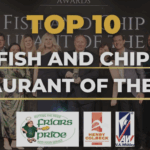There’s only one topic of conversation currently dominating, and that is rising fish prices. But why are they jumping up and what can operators do to adapt and stay ahead?
“In the last six weeks, my fish has gone up £60 a case, that’s a 33% increase and I’ve been told it’s only going to go up further,” says Geoff Whitehead, owner of Whiteheads Fish & Chips in Hornsea, East Yorkshire.
Now paying £185 for a case of haddock and £230 for cod, Geoff has been advised by industry trade body The NFFF that cod could soon reach £300 a box and, with more shops switching to haddock, further price rises are predicted there too.
“It’s just not sustainable,” says Geoff concerned. “It’s not sustainable at £225 a box. You can’t make any money off of it, because people won’t pay the price.”
It’s the same situation for friers across the country, who are grappling with rising prices due in part to the reduction in the 2025 quota for Atlantic cod in the Barents Sea to 340,000 tonnes. Not only is this a 25% decrease from the previous year, but it is also the lowest allocation since 1991. Predictions are that future cod quotas will remain low until 2028 to allow time for the stocks to recover.
Bobby Joyce, sales and marketing director at Hull-based fish merchant Smales, gives some context to the situation, saying in 2014 the quota was 1 million tonnes. “In just over a decade, we have seen a significant drop of over 60% in the total allowable catch. After the pandemic, there was a percentage of quota carried over into the following years which helped offset the impact of the reductions in quota, but that surplus has now been fully exhausted.”
Bobby also highlights that strong demand from processors in China and Europe is compounding the issue, along with reduced fish supplies from Russian vessels to the UK due to the lower quotas and increased tariffs. On top of this, fishing vessels face rising costs for fuel and labour, further impacting the value of the reduced quota volumes.
“Unfortunately the situation is not ideal on fish supply and prices, in the immediate future or for the year ahead,” he explains. “Cod is currently trading for some of the highest prices we have seen, which is unheard of while we are in the quietest period of the year, and haddocks are also on the increase, although they were forced to a very low level in 2023 and are now getting back to what I’d consider a more realistic level.”
Warning that as we get further into the year and demand increases, there is the potential for further pressure on the price of white fish, Bobby is keen to reassure shop owners that major importers like Smales are working with the quota holders to keep prices as fair and realistic as the market conditions will allow. He adds: “They all take great pride in the strong ties between our countries and the supply to the UK’s most famous of dishes which, despite the difficult climate of supply and demand we face right now, will continue for generations to come.”
While this provides some reassurance to shop owners, it’s more critical than ever for businesses to focus on portion control, precise cutting, and minimising waste. But what other steps can be taken to stay profitable during these challenging times?
Think outside the box
“You’ve got to think outside the box,” says Geoff Whitehead, who instead of increasing the price of his fish, has added 10p on chips. “Yes, the price of fish and chips have gone up because I’ve put it on the chips, but I’m gaining on almost every customer because everybody has chips, whether it’s fish and chips, sausage and chips or pie and chips.”
Whiteheads has also introduced an all-day special: half a regular fish and chips, peas, curry, gravy and beans for £7.10. With regular fish and chips costing £11.20, it’s an attractive offer – and it’s exactly this that is getting customers through the door. “It looks more favourable because it’s cheaper but it’s still a good portion and the profit from it is good so I’m only going to gain.”


At Ship Deck in Caerphilly the price of cod and chips has also risen in the past four weeks, from £9.70 to £11.75. This is in response to a 30% increase in the price owner Ryan Hughes is paying for cod, going from £180 a case to £235.
“My fish supplier has been open and said it is going to hit £280-£285 a case, but there’s further talk of seeing £290-£300 a case. That’s a drastic increase,” he says.
To help protect his margins, Ryan has found a clever way to cut his fish to ensure maximum yield per fillet. “I butterfly my fillets,” he says.
Buying 16-32oz, once the pin bone has been removed and the fish trimmed, he butterflies the bottom section to get two, sometimes three, fillets. “I’m also getting a piece out of the tail, and then off the side of the tail I’m getting a fish bite.” It doesn’t stop there – Ryan also manages to cut thin bits from the top which he uses as popcorn fish, serving six to a portion for £5.95.
By cutting this way, Ryan has found he not only maximises each piece of fish but that each fillet is roughly the same thickness. “It’s slightly thinner – but still a nice, chunky fillet – so you get an even fry and also the cooking time is reduced,” he says.
Another option Ryan has found to help counteract rising fish prices is utilising low-cost, high-profit margin items for his menu, like calamari. Costing £4.40 for five fresh squid tubes, Ryan gets a portion out of each tube which he sells at £6.95.
“Calamari is one of those items where a husband and wife will come in for fish and chips each and have a portion between them as an add-on. I’m selling that for £6.95 and it’s costing me pennies”. Another item is homemade onion rings. He adds: “It’s just looking at the menu and saying, why am I buying a bag of frozen onion rings when I can buy a net for £6 and get literally hundreds of portions out of them for £2.50? Maximising profit during these times is really important.”
Switching species
At the Cod’s Scallops in Nottingham, owner John Molnar has taken small cod off the menus across all five sites and replaced it with haddock. It was a move he was nervous about, being in a strong cod area, but with prices going up, it was deemed necessary.
“We sell probably eight or nine cod to one haddock so I was worried, but apart from one or two real old boys that don’t like haddock – we just cut a small cod from a large cod for them – no one else has blinked,” says John. “I’ve gained maybe 20p a portion on what I was paying for the cod, which might not sound much but that’s a lot when you’re doing the volume we are times five shops.”


With a price increase in January pushing his takeaway fish and chips to £13.50, John introduced a Monday Madness at the same time to deflect attention away. Offering a mini haddock, chips, any sauce and a can of drink for £5, takings have doubled with some shops now putting through the till on a Monday what they do on a Friday. And the best part – it’s almost all new customers.
“Because we positioned it at £5, it’s people that would go to Greggs or get a meal deal from Boots. The number of people that come in and say “12 of your Monday Madness” because it’s the offices going, let’s have a chippy on a Monday because it’s only a fiver. Okay, I’m not making tons of money on it, but a) it’s the quietest day in the week and b) it’s people that wouldn’t have come to me.”
The market remains volatile, so operators must stay vigilant, stay in close contact with their fish suppliers, adapt quickly, and maintain a positive front for customers. If prices must rise, do so quietly – advertising higher costs can deter customers. Instead, focus on getting them in the door, where you can explain and offer alternatives that work for both parties.
The Cod’s Scallop’s John Molnar emphasises this, saying: “We need to stay strong and focus on the product. There’s too much negativity about rising costs. Last year, there was a massive rice shortage with no exports from Bangladesh or India because they didn’t have enough to feed themselves. Rice prices jumped 30-40%, yet no Indian restaurants were panicking publicly. They simply put up their prices.
“We need to look at the bigger picture. Ounce for ounce, fish remains the best value takeaway on the high street. That should be our message.”
Recent Posts
- Erling Haaland backs new campaign for Norwegian salmon
- Hospitality sector struggles to invest as operational costs surge
- Fish & Chip Takeaway of the Year 2026 semi-finalists announced
- Deliveries up but takeaways down as new openings lift at-home sales in August
- National Fish & Chip Awards announce 2026 Restaurant of the Year front-runners








